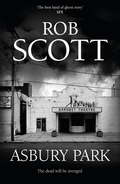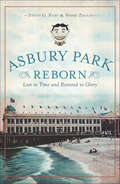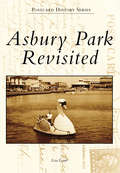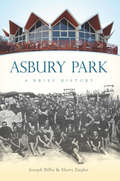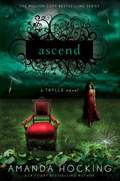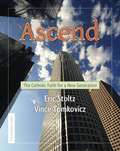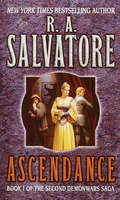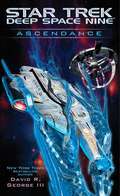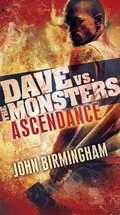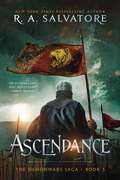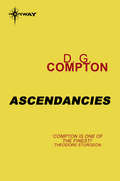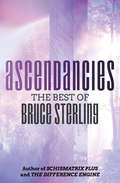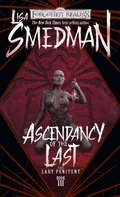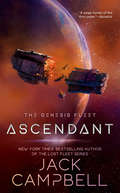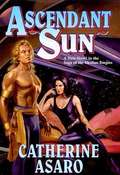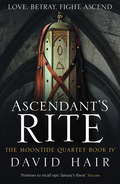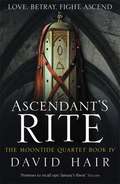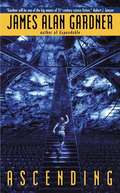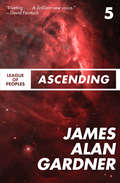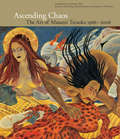- Table View
- List View
Asbury Park
by Rob ScottA thrilling police procedural with supernatural elements, for fans of Patricia Cornwell, John Connelly and Stephen KingTen weeks ago, Homicide Detective Sailor Doyle worked his first solo case, a gruesome double murder in a remote farmhouse in Virginia. And things turned very nasty for him ...Now Sailor is recuperating with his family at a beach house in Belmar, on the New Jersey shore. He's struggling with prescription drug withdrawal while trying to build up his shattered shoulder and leg, and he's also trying to rebuild his shattered relationship with his wife. Jenny, while pleased he's alive, is less enamoured with the idea of reconciliation. Seeking refuge in a century-old beachfront resort hotel, Sailor meets an elderly man, Mark "Moses" Stillman, a former minor league baseball player whose wife and daughter drowned in the ocean off Belmar years earlier. Sailor's having nightmares about his previous case, and when he starts seeing things again, he realises that once again he's being guided to the truth ... even if it's not what he wants to hear. And it's not long before he finds himself investigating those deaths.
Asbury Park Reborn: Lost to Time and Restored to Glory (Landmarks)
by Harry Ziegler Joseph G. BilbyAsbury Park's diverse array of landmarks creates an unforgettable impression of this legendary seaside city. They tell the story of its past, present and even future. The elegant, Art Deco-inspired Convention Hall captures the resort's glittering heyday in the 1920s and '30s, while structures like the Upstage seem to echo with the voices of aspiring musicians like Bruce Springsteen when they played at intimate venues, defining Asbury's world-renowned music scene. As the city forges ahead with ambitious redevelopment plans, many neglected buildings have been rehabilitated, but others continue to deteriorate, despite a groundswell of public opposition. From opulent movie houses to down-and-dirty rock-and-roll clubs, these landmarks trace the evolution of Asbury Park from a tiny nineteenth-century resort town to the world-famous playground of today.
Asbury Park Revisited (Postcard History)
by Lisa LambWhen New York brush manufacturer James Bradley founded Asbury Park in the late 1800s, he could hardly have imagined the course his seaside resort would take. Named for Methodist Episcopal bishop Francis Asbury, it was originally a Christian resort awash in Victorian architecture. Throughout the first half of the 20th century, Asbury Park's beach, boardwalk, restaurants, theaters, hotels, and amusements attracted thousands of vacationers every year. Later, the town gained a reputation as a gritty music mecca, known for the clubs where Bruce Springsteen got his start. All along, Asbury Park has had a unique ability to draw people to it, evidenced by the thousands of postcards sent home from the town each year.
Asbury Park: A Brief History
by Harry Ziegler Joseph G. BilbyThe history of Asbury Park is a veritable roller coaster of challenge, triumph and change. In 1871, there was nothing but marshes and sand dunes between the sinful city of Long Branch and the holy haven of Ocean Grove, but for devout Methodist James Bradley, the deserted beachfront was a new Promised Land. Thus, the resort community Asbury Park was born as a wholesome entertainment and relaxation center for middle-class, white Protestant America. From bicycles and baby parades to brawlers and bootleggers, Bilby and Ziegler trace Asbury Park's cycles of transformation from peaceful resort to raucous amusement park, from empty boardwalk to modern, bustling center of business.
Ascend (Trylle Trilogy: #3)
by Amanda HockingDuty-bound to marry her friend Tove in order to give the Trylle people their strongest king and queen in history, Wendy, a changeling troll princess, is torn between two other suitors, Finn and Loki.
Ascend: The Catholic Faith for a New Generation
by Eric Stoltz Vince TomkoviczAscend: The Catholic Faith for a New Generation is an approachable, clearly written, and contemporary exploration of the Catholic faith aimed at young adults. Precisely with this audience in mind, it is designed with full-color graphics, short chapters, and interesting sidebar articles that cover the basics of Christianity from a viewpoint that is distinctively Catholic yet ecumenical. The format allows the reader to read chapters as time is available, rather than studying a long, linear text. Sidebar stories in each chapter profile a role model and offer a Christian viewpoint on some aspect of current events. The book also serves as an effective gateway to Scripture, guiding the reader to passages that flesh out ideas in the way only Revelation can. Ascend aims to instill in the reader a true personal connection with the person of Jesus Christ and an active appreciation of the reader's role in the Church. Discussion questions and book recommendations are included for each chapter, as well as an extensive glossary. This one-of-a-kind book will certainly fill a need for a relevant, attractive, yet penetrating overview of the faith for young people.
Ascendance (Demon Wars, Second Saga #1)
by R. A. SalvatoreMuch to the seething dismay of his long time mistress, King Danube has asked Jilseponie Wyndon to become his queen. But she is torn. How can she love any man as completely as she did the Ranger Elbryan, the father of the child she lost? But unknown to Jilseponie, that child never died. Aydrian was stolen away by the queen of the elves. A headstrong boy secretly raised to be a weapon, Aydrian shows great promise in the arts of combat-and he is as powerful with the gemstone magic as his mother. Now De'Unnero, the weretiger and mortal enemy of Jilseponie, will join forces with Aydrian, who is hungry for power-and on a collision course with destiny. . . .
Ascendance (Star Trek: Deep Space Nine)
by David R. George IIIThe post-television Deep Space Nine saga continues with this original novel from New York Times bestselling author David R. George III!On the original Deep Space Nine, Captain Kira Nerys watches as the nearby wormhole opens and discharges a single, bladelike vessel. Attempts to contact its crew fail, and the ship is soon followed by another vessel of similar design. When an armada subsequently begins to emerge from the wormhole, it seems clear that DS9 is under attack. Kira orders her first officer, Commander Elias Vaughn, to board the U.S.S. Defiant and defend the station, and alerts Starfleet to send additional forces as her crew prepares DS9’s shields and weaponry for the onslaught to come. Meanwhile, on the lead ship, Iliana Ghemor considers launching an attack on DS9 and finally ending the life of Kira, the fountainhead of all the ills in her miserable life. Her vengeance demands more than mere death, though—it requires pain. Ghemor refocuses, choosing to follow her plan to mete out her revenge on the captain by first decimating the population of Bajor… ™, ®, & © 2015 CBS Studios, Inc. STAR TREK and related marks and logos are trademarks of CBS Studios, Inc. All Rights Reserved.
Ascendance: Dave vs. the Monsters
by John BirminghamFor fans of Jim Butcher and Kevin Hearne comes an exhilarating new urban fantasy series featuring monster-slayer Dave Hooper and his magical splitting maul. Kids, there are no monsters under the bed. They're in the front yard. As a hardworking monster-slayer, Dave Hooper tries not to bring his work home with him. But nowadays it's hard to keep them separate. Email, cellphones, empath daemons, they never let a guy rest. The Horde has been raising hell and leveling cities from New York to Los Angeles, keeping Dave and his fellow monster-killer, Russian spy Karin Varatschevsky, very busy. But when the legions of hell invade the small seaside town his boys call home, Dave has to make a call. Save the world? Or save his family? Not as easy a choice as you'd think, since Dave's ex-wife expects to be saved too. And there's no convincing her that the supersexy Russian spy isn't his girlfriend. She's just his sidekick--and an assassin.
Ascendance: The DemonWars Saga, Book 5 (DemonWars series #5)
by R. A. SalvatoreYears have passed since the great miracle atop Mount Aida, and Corona is a different place—yet a threat looms, one Kilseponie could never have anticipated in this next installment in the DemonWars series from bestselling author R. A. Salvatore.Much to the seething dismay of his long-time mistress, King Danube has asked Julsepnie Wyndon to become his queen. But she is torn. How can she love any man as completely as she did the Ranger Elbryan, the father of the child she lost? But unknown to Jilseponie, that child never died. Aydrian was stolen away by the queen of the elves. A headstrong boy secretly raised to be a weapon, Aydrian shows great promise in the arts of combat, and he is as powerful with the gemstone as his mother. Now, De&’Unnero, the weretiger and mortal enemy of Jilseponie, will join forces with Aydrian, who is hungry for power and on a collision course with destiny. Building upon the events in Mortalis, #1 New York Times bestselling author R.A. Salvatore continues the fresh second trilogy within the DemonWars saga with his fifth book in the series.
Ascendancies
by D. G. ComptonInto a future where a depleted fuel supply had the world spiralling down into grinding poverty and constant war came . . . Moondrift. Mysterious white flakes of alien matter that was the perfect fuel - clean powerful, dependable. But the aliens - or whatever they were - who sent Moondrift seemed to demand a heavy ransom in return. After each Moondrift comes an eerie sound, as pure as a children's choir, heard all over the world. It mesmerises all who hear it with it's beauty - and when it is ended, certain people have simply disappeared without warning, never to be seen again. This is the story of one who disappeared . . .
Ascendancies
by D.G. ComptonInto a future where a depleted fuel supply had the world spiralling down into grinding poverty and constant war came . . . Moondrift. Mysterious white flakes of alien matter that was the perfect fuel - clean powerful, dependable.But the aliens - or whatever they were - who sent Moondrift seemed to demand a heavy ransom in return. After each Moondrift comes an eerie sound, as pure as a children's choir, heard all over the world. It mesmerises all who hear it with it's beauty - and when it is ended, certain people have simply disappeared without warning, never to be seen again.This is the story of one who disappeared . . .
Ascendancies: The Best of Bruce Sterling
by Bruce SterlingTwo dozen tales of future shock and twisted history from an undisputed king of cyberpunk science fiction, including Nebula Award finalists &“Sunken Garden&” and &“Dori Bangs.&”Time magazine describes Bruce Sterling as &“one of America&’s best-known science fiction writers and perhaps the sharpest observer of our media-choked culture working today in any genre.&” Sterling&’s abilities are on full display in Ascendancies, a collection of speculative fiction from a world-class world-building futurist, alternate historian, and mad prophet operating at the peak of his extraordinary powers. Here are twenty-four stories that span the illustrious career of the author who, along with William Gibson and Neal Stephenson, injected the word cyberpunk into the science fiction lexicon. These tales not only traverse galaxies and employ mind-boggling technologies, they also cut back across the centuries into a richly imagined past with style and a sharp satiric edge. Sterling&’s unparalleled imagination and courageous originality carry the reader into the future universe of the warring Shapers and Mechanists, rival sects of exiled humanity with radically opposed views of human augmentation. Several stories feature the questionable adventures of the footloose con man Leggy Starlitz in a somewhat-skewed and still-dangerous post–Cold War world. Sterling explores the cyberpunk trope of technology gone wild and the resultant decline of civilization with appropriate gravity, while presenting parables of strangers stuck in very strange lands in a more whimsical vein. Whether chronicling an alien&’s encounter with Crusaders in disputed Palestine, depicting the discovery of the key to immortality in a nineteenth-century Times Square magic shop, or portraying bicycles and bad guys in a near-future Tennessee, Sterling&’s stories are smart, surprising, genre bending, bold, and outstanding, one and all.
Ascendancy Women and Elementary Education in Ireland: Educational Provision for Poor Children, 1788 - 1848
by Eilís O'SullivanThis book outlines the lives of six female members of the Irish Ascendancy, and describes their involvement with educational provision for poor children in Ireland at the end of the long eighteenth century. <P><P>It argues that these women were moved by empathy and by a sense of duty, and that they were motivated by political considerations, pragmatism and, especially, religious belief. The book highlights the women’s agency and locates their contribution in international and literary contexts; and by exploring sources and evidence not previously considered, it generates an enhanced understanding of Ascendancy women’s involvement with the provision of elementary education for poor Irish children. This book will appeal to scholars and researchers in the fields of Education and History of Education. It will also have broad appeal for those interested in Gender and Women’s Studies, in Georgian Ireland and in the history of Ascendancy families and estates.
Ascendancy of the Last (Lady Penitent #3)
by Lisa SmedmanIs it the end for the Lady Penitent? Is it the end for Lolth? Lolth has come out of hibernation with a plan that may seem too ambitious even for her, and to pull it off she'll need the help of a drow who's betrayed her at least once already--a drow she's transformed into the demonic Lady Penitent. The shocking conclusion to a trilogy that will change theForgotten Realmsworld forever.
Ascendant
by Diana PeterfreundAstrid Llewelyn is now a fully trained unicorn hunter, but she can't solve all her problems with just a bow and arrow. Her boyfriend, Giovanni, has decided to leave Rome, the Cloisters is in dire financial straits, her best friend's powers seem to be mysteriously disintegrating, and Astrid can't help but feel that school, home, and her hopes of becoming a scientist are nothing but impossible dreams. So when she's given the opportunity to leave the Cloisters and put her skills to use as part of a scientific quest to discover the Remedy, Astrid leaps at the chance. Finally, she can have exactly what she wants-or can she? At Gordian headquarters, deep in the French countryside, Astrid begins to question everything she thought she believed: her love for Giovanni, her loyalty to the Cloisters, and-most of all-her duty as a hunter. Should Astrid be saving the world from killer unicorns, or saving the unicorns from the world?
Ascendant (Genesis Fleet, The #2)
by Jack CampbellA young fleet officer and a Marine stand together to defend their colony in the continuation of the powerful and action-packed Genesis Fleet saga from New York Times bestselling author Jack Campbell.In the three years since former fleet officer Rob Geary and former Marine Mele Darcy led improvised forces to repel attacks on the newly settled world of Glenlyon, tensions have only gotten worse.When one of Glenlyon's warships is blown apart trying to break the blockade that has isolated the world from the rest of human-colonized space, only the destroyer Saber remains to defend it from another attack. Geary's decision to take Saber to the nearby star Kosatka to safeguard a diplomatic mission is a risky interpretation of his orders, to say the least.Kosatka has been fighting a growing threat from so-called rebels--who are actually soldiers from aggressive colonies. When a "peacekeeping force" carrying thousands of enemy soldiers arrives in Kosatka's star system, the people of that world, including Lochan Nakamura and former "Red" Carmen Ochoa, face an apparently hopeless battle to retain their freedom. It's said that the best defense is a good offense. But even if a bold and risky move succeeds, Geary and Darcy may not survive it...
Ascendant Sun (Saga of the Skolian Empire, Book #5)
by Catherine AsaroFollows The Last Hawk and features the same leading character, Kelricson Garlin Valdoria.
Ascendant's Rite: The Moontide Quartet Book 4 (The Moontide Quartet #4)
by David HairLove. Betray. Fight. Ascend. In the much-anticipated conclusion to The Moontide Quartet, the fate of Urte will be decided on the mighty Leviathan Bridge.'Recommended for fans of George R.R. Martin, Brandon Sanderson, and Patrick Rothfuss' Monster LibrarianEmperor Constant is finally ready to conquer the world.As Alaron and Ramita struggle to recover the key to the Ascendants' magic as well as one of Ramita's infant sons, Queen Cera must fight to take the reins of power and Seth Korion's Lost Legions desperately search for safety while trapped between two massive armies.The time has come for the Rite of Ascendancy to be performed, and for new powers to rise to save - or damn - Urte.The Moontide is ending.'Modern epic fantasy at its best' - Fantasy Book Critic
Ascendant's Rite: The Moontide Quartet Book 4 (The Moontide Quartet #4)
by David HairLove. Betray. Fight. Ascend. In the much-anticipated conclusion to The Moontide Quartet, the fate of Urte will be decided on the mighty Leviathan Bridge.'Recommended for fans of George R.R. Martin, Brandon Sanderson, and Patrick Rothfuss'Monster LibrarianEmperor Constant is finally ready to conquer the world.As Alaron and Ramita struggle to recover the key to the Ascendants' magic as well as one of Ramita's infant sons, Queen Cera must fight to take the reins of power and Seth Korion's Lost Legions desperately search for safety while trapped between two massive armies.The time has come for the Rite of Ascendancy to be performed, and for new powers to rise to save - or damn - Urte.The Moontide is ending.'Modern epic fantasy at its best' - Fantasy Book Critic
Ascendant's Rite: The Moontide Quartet Book 4 (The\moontide Quartet Ser. #4)
by David HairThe last few months of the moontide - when the bridge connecting East and West rises above the sea - has come, and in the West Emperor Constant prepares the final phase of his plan to conquer the East.For failed mage Alaron and his companion Ramita - widow to the mage who built the Leviathan Bridge - the unthinkable has happened. They have lost the Scytale of Corineus, the key to the Rite of Ascendancy, as well as one of Ramita's infant sons, to the hands of their deadliest enemies.In Javon, Cera Nesti, the imprisoned queen, has been freed, and plots to take on the overwhelming might of the Rondian Empire. But standing between her and her goal is a band of deadly mercenaries playing a dangerous game of their own.And in the East, Seth Korion's Lost Legions must navigate treacherous roads to gain safety, bearing secrets that could bring down the Emperor.The time has come for the Rite of Ascendancy to be performed. New powers must rise to save or damn Urte, and on the mighty Leviathan Bridge itself, all will be decided.
Ascendency of the Last
by Lisa SmedmanIs it the end for the Lady Penitent? Is it the end for Lolth? Lolth has come out of hibernation with a plan that may seem too ambitious even for her, and to pull it off she'll need the help of a drow who's betrayed her at least once already--a drow she's transformed into the demonic Lady Penitent. The shocking conclusion to a trilogy that will change the Forgotten Realms world forever.From the Paperback edition.
Ascending
by James Alan GardnerOar is the last of her kind -- a resident of the so-called "planet of no return," once the Admiralty's dumping ground for undesirables and those who had become expendable. Oar's transparent body is indestructible. Yet the mind it houses grows weary and will soon surrender to the catatonic torpor that has already claimed the others of her genetically altered human race. But Oar cannot sleep, not yet. There are powerful forces seeking her destruction for reasons unknown. There are old allies who need her assistance and a true history that must be revealed. There is much Oar must accomplish before the "apathetic hibernation" overcomes her, though time is decidedly her enemy. Together with her friend, Admiral Festina Ramos, she must find her final destiny ... and in a vast and volatile universe, destiny is never a sure thing.
Ascending (League of Peoples #5)
by James Alan GardnerLeft to languish on the planet of no return, an alien teams up with a professional smuggler to save her people in this sci-fi adventure. Four years after Festina Ramos left Melaquin, the &“planet of no return,&” Uclodda Unorr arrives. Unorr is a hired smuggler tasked with gathering evidence of misconduct of the Technocracy&’s Outward Fleet. Much to his surprise he discovers that Oar, a resident of the planet and last of her kind, is still alive. Though Oar&’s glass-like body is indestructible, her mind grows weak and will soon fall victim to &“apathetic hibernation.&” Along with her old friend Admiral Festina Ramos, Oar must reveal the true history of Melaquin and expose the ugly deeds of the Outward Fleet before her weary mind surrenders.
Ascending Chaos: The Art of Masami Teraoka 1966-2006
by Eleanor Heartney Masami Teraoka Catharine Clark Alison Bing Kathryn A. Hoffman<p>Ascending Chaos is the first major retrospective of Japanese-American artist Masami Teraoka's prolific and acclaimed work thus far. In Teraoka's paintings—which have evolved from his wry mimicry of Japanese woodblock prints to much larger and complex canvasses reminiscent of Bosch and Brueghel—the political and the personal collide in a riot of sexually frank tableaux. <p>Populated by geishas and goddesses, priests, and politicians, and prominent contemporary figures, these paintings are the spectacular next phase of a wildly inventive career. With essays by renowned art critics who discuss how Teraoka's work inventively marries east and west, sex and religion, Ascending Chaos is a critical overview of this cultural trickster.</p> <p>This is a fixed-format ebook, which preserves the design and layout of the original print book.</p>
